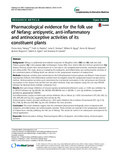| dc.description.abstract | Abstract
Background
Nefang is a polyherbal anti-malarial composed of Mangifera indica (
MiB and MiL; bark and leaf), Psidium guajava (
Pg
), Carica papaya (
Cp
), Cymbopogon citratus (
Cc
), Citrus sinensis (
Cs
) and Ocimum gratissimum (
Og
) (leaves). Previous studies have demonstrated its in vitro and in vivo antiplasmodial activities, antioxidant properties and safety profile. This study aimed at evaluating the antipyretic, anti-inflammatory and antinociceptive activities of the constituent plants of Nefang which are relevant to the symptomatic treatment of malaria fever.
Methods
Antipyretic activities were determined by the D-Amphetamine induced pyrexia and Brewer’s Yeast induced hyperpyrexia methods. Anti-inflammatory activities were investigated using the carrageenan-induced rat paw edema method. Antinociceptive activities were determined by mechanical nociception in the tail pressure and thermal nociception in the radiant heat tail flick and hot plate methods. Data was analysed using the one way ANOVA followed by Neuman-Keuls multiple comparison test.
Results
Best percentage inhibition of induced pyrexia (amphetamine/brewer’s yeast; p < 0.05) was exhibited by Cc (95/97) followed by Og (85/94), MiL (90/89), MiB (88/84) and Cs (82/89). Cc and Og exhibited comparable activities to paracetamol (100/95).
Anti-inflammatory studies revealed paw edema inhibition (%) as follows (p < 0.05): Indomethacin (47), MiL (40), Cp (30), MiB (28) and Og (22), suggesting best activity by MiL.
Antinociceptive studies revealed significant (p < 0.01) pain inhibition (%) as follows: Paracetamol (97), Og (113), MiL (108), Pg (84) and MiB (88). Og and MiL exhibited the best activities.
Conclusion
The results obtained suggest that the constituent plants possess biologically active compounds with antipyretic, anti-inflammatory and antinociceptive activities. These activities are essential in the symptomatic treatment of malaria fever, thereby justifying the folk use of Nefang. This would be useful in its subsequent development for clinical application. | |

